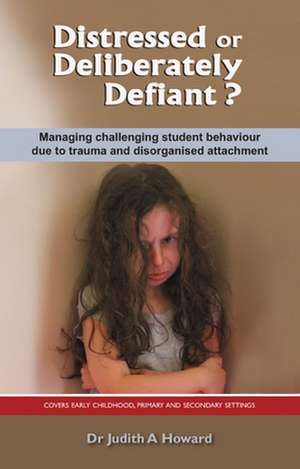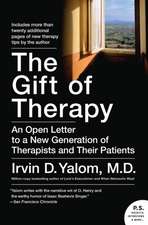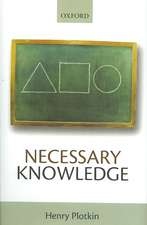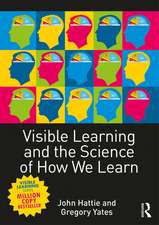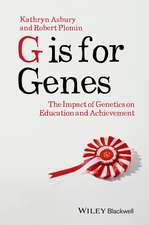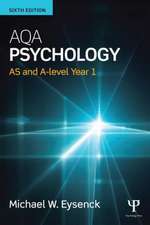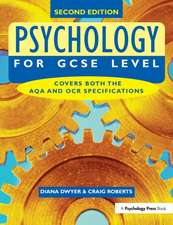Distressed or Deliberately Defiant?: Managing Challenging Student Behaviour Due to Trauma and Disorganised Attachment
Autor Judith A. Howarden Limba Engleză Paperback – 30 apr 2013 – vârsta de la 18 până la 22 ani
Preț: 165.98 lei
Nou
Puncte Express: 249
Preț estimativ în valută:
31.76€ • 34.49$ • 26.68£
31.76€ • 34.49$ • 26.68£
Carte tipărită la comandă
Livrare economică 22 aprilie-06 mai
Preluare comenzi: 021 569.72.76
Specificații
ISBN-13: 9781922117151
ISBN-10: 1922117153
Pagini: 104
Dimensiuni: 137 x 211 x 5 mm
Greutate: 0.14 kg
Editura: Australian Academic Press
ISBN-10: 1922117153
Pagini: 104
Dimensiuni: 137 x 211 x 5 mm
Greutate: 0.14 kg
Editura: Australian Academic Press
Notă biografică
Dr Judith Howard is the Regional Manager for Behaviour Support Services for the Department Education Training and Employment in Queensland where she oversees a specialist intervention team, student support programs and training. She has previously worked as an educator, a child and adolescent behaviour specialist, a school counsellor and a researcher. Dr Howard has a passion for educating educators and other professionals from government and non-government agencies who are involved in the support of children and young people who present with challenging behaviour and attachment/ trauma related backgrounds, with the goal of enhancing collaborative child and adolescent support practices
Extras
It is not unusual for teachers to be confronted with the annoyance of having to deal with challenging student behaviour. Despite our preference that it is not so, student behaviour does tend to have a considerable impact on the delivery of teaching and learning programs and, in many cases, the personal or emotional wellbeing of teachers, both during school and after hours. In most cases, teachers accept this as part of their professional experience. They speak of good and bad years and great and no-so-great classes that they have taught and, more often than not, these evaluations will refer to the types of student misbehaviour they needed to manage. Details of these good and bad years and great and not-so-great classes tend to fade from memory over time.
However, teachers can find it very difficult to erase from their memories the particular type of student who will be discussed in this book. They tend to easily recall these students by name, even many years after they have moved on from their classrooms. They report uneasiness when working with these students and feelings that there was something “not quite right” with them. They remember how quickly and unexpectedly these students flew into behavioural outbursts with little warning and as a result of no clear triggers. They suggest they had much difficulty getting through to these students, or, just when they felt that they did, the students would then sabotage the relationships in some way, leaving them feeling surprised and perhaps, shocked, hurt or annoyed. They recall these students having extreme challenges responding to adult authority and having even more trouble with relating appropriately to their peers. These students tended to respond poorly to tried-and-true behaviour management processes that worked well with the rest of their students. Often, the behaviours of these students left them with little choice but to resort to withdrawing them from class activities or removing them from class altogether. It is likely these students would have been suspended or perhaps even expelled from school at some stage. Dealing with the needs and behaviours of these students was a daily occurrence, leaving teachers feeling tired and dissatisfied with their jobs and perhaps leading them to taking more days off work than usual. Indeed, teachers often reflect that the period of time they spent teaching these students was a time when they questioned their capabilities as educators and sometimes even their choice of career.
. . .
Student behaviour management has become a very real part of teachers’ professional experience and there are ever-growing expectations for schools to further develop their educators’ expertise within this field. Many amazing thinkers have provided us with a multitude of valuable theories and techniques to help prevent challenging student behaviour from occurring and to minimise or address such behaviour when it does occur. Some teachers new to, and established within, the profession joke about “never smiling during the first school term” in their efforts to establish early their control and their required classroom behavioural standards. They clearly communicate their authority and their right to encourage and dissuade particular student behaviours through reward, punishment and other processes. In many cases, these teacher practices are drawn from whole-school frameworks, supported by policies that articulate what is approved student behaviour and what is not, and how the adults running the school will respond to each.
However, general behaviour management is not the topic of his book. Rather, this book will focus on the very specific needs of a particular student group that is causing growing concern within our schools. Despite this group being small in number when compared to overall student populations, it has proven to be disproportionately concerning and costly for schools. These students can require inordinate amounts of staff time and school resources to teach and manage and, despite the investment, concerning behaviours can persist.
However, teachers can find it very difficult to erase from their memories the particular type of student who will be discussed in this book. They tend to easily recall these students by name, even many years after they have moved on from their classrooms. They report uneasiness when working with these students and feelings that there was something “not quite right” with them. They remember how quickly and unexpectedly these students flew into behavioural outbursts with little warning and as a result of no clear triggers. They suggest they had much difficulty getting through to these students, or, just when they felt that they did, the students would then sabotage the relationships in some way, leaving them feeling surprised and perhaps, shocked, hurt or annoyed. They recall these students having extreme challenges responding to adult authority and having even more trouble with relating appropriately to their peers. These students tended to respond poorly to tried-and-true behaviour management processes that worked well with the rest of their students. Often, the behaviours of these students left them with little choice but to resort to withdrawing them from class activities or removing them from class altogether. It is likely these students would have been suspended or perhaps even expelled from school at some stage. Dealing with the needs and behaviours of these students was a daily occurrence, leaving teachers feeling tired and dissatisfied with their jobs and perhaps leading them to taking more days off work than usual. Indeed, teachers often reflect that the period of time they spent teaching these students was a time when they questioned their capabilities as educators and sometimes even their choice of career.
. . .
Student behaviour management has become a very real part of teachers’ professional experience and there are ever-growing expectations for schools to further develop their educators’ expertise within this field. Many amazing thinkers have provided us with a multitude of valuable theories and techniques to help prevent challenging student behaviour from occurring and to minimise or address such behaviour when it does occur. Some teachers new to, and established within, the profession joke about “never smiling during the first school term” in their efforts to establish early their control and their required classroom behavioural standards. They clearly communicate their authority and their right to encourage and dissuade particular student behaviours through reward, punishment and other processes. In many cases, these teacher practices are drawn from whole-school frameworks, supported by policies that articulate what is approved student behaviour and what is not, and how the adults running the school will respond to each.
However, general behaviour management is not the topic of his book. Rather, this book will focus on the very specific needs of a particular student group that is causing growing concern within our schools. Despite this group being small in number when compared to overall student populations, it has proven to be disproportionately concerning and costly for schools. These students can require inordinate amounts of staff time and school resources to teach and manage and, despite the investment, concerning behaviours can persist.
Textul de pe ultima copertă
It is not unusual for educators today, whether in the early childhood, primary or secondary sectors, to be confronted with severely challenging student behaviour - students who fly into unexplained violent and oppositional outbursts with little warning; who respond poorly to tried-and-true behaviour management processes. Such behaviour has considerable impact on the delivery of teaching and learning programs and the emotional wellbeing of the teachers themselves as well as raising safety risks for the entire school community.
This book explains the basis for such behaviour as the neurological, physiological and behavioural outcomes of "disorganised attachment" due to prolonged exposure to a traumatic home life and provides practical advice to educators on ways that schools can effectively manage these students. By examining the science behind attachment theory, the neurobiology of behaviour, and the manifestation of disorganised attachment in the school context, this book will help educators:
• minimise such challenging behaviour,
• manage crises and disciplinary responses such as suspension and expulsion,
• improve student compliance,
• enhance education and overall wellbeing, and
• deal with parents.
Covers early childhood, primary and secondary settings.
This book explains the basis for such behaviour as the neurological, physiological and behavioural outcomes of "disorganised attachment" due to prolonged exposure to a traumatic home life and provides practical advice to educators on ways that schools can effectively manage these students. By examining the science behind attachment theory, the neurobiology of behaviour, and the manifestation of disorganised attachment in the school context, this book will help educators:
• minimise such challenging behaviour,
• manage crises and disciplinary responses such as suspension and expulsion,
• improve student compliance,
• enhance education and overall wellbeing, and
• deal with parents.
Covers early childhood, primary and secondary settings.
